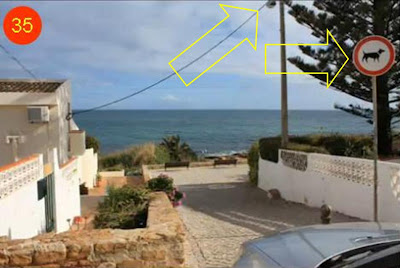
We have determined, at this point, two important things about "The Stroller".
One is that he was NOT DISPOSING OF OR HIDING A BODY.
The other is that he was carrying the child with the CLEAR INTENT OF BEING SEEN carrying a blond, barefooted four year old girl, dressed in pyjamas, and so provoke an encounter that had the objective to produce one or more witnesses who would be misleaded into thinking that Madeleine Beth McCann had just been abducted.
These are two of the three intermediate objectives we proposed to achieve before advancing to the final one in the Smith Sighting Saga: to prove that "The Stroller" is none other than Dr. Gerry McCann.
This post, and the others that will follow it, is then aimed to achieve the third intermediate objective: to prove that the carried girl was alive.
I’ll even add another detail to the objective: to prove that she was alive and sedated.
For this, I’ll be breaking the theme into three parts.
- First, this post, is to differentiate, physically, the dead from the live. Simplistically as possible, of course.
- Then, I intend to show how, and why, ANY adult carries a small sleeping toddler, under various circumstances.
- Lastly, I intend to show how, and why, is a dead human body, namely that of a child, is transported.
The proving of the sedation, is about a paragraph long, so I’m still thinking if I’ll dedicate a post to such evident evidence.
That’s the plan. But you know by now how fickle I am…
Let’s then not waste any more time, and get the ball rolling.
A Portuguese “socialite”, Lili Caneças, has, in Portugal where she’s known, been much scorned for having one day said that “being alive is the opposite of being dead”.
This apparently obvious statement does encapsulate much more than it seems.
There are, I’ve heard, ongoing discussions about what is the exact moment a person dies. A very good friend of mine has told me that the last thing to go is the hearing, so, on a loved one's deathbed one should continue to speak caring, loving words, as the loved one departs before our very own eyes.
I certainly would like to go hearing such music.
But it’s not the moment of death that I want to talk about today.
I intend to discuss what is PHYSICALLY different from a dead body and one that is living, in a conscious state or not.
In terms of conscientiousness I would say that someone can go from fully alert and conscientious, to being completely unconscious, like when under general anesthesia.
The intermediate degrees in this scale would be to be drowsy, asleep or sedated.
I’ll leave the comatose state out as in none of the Maddie’s scenarios is this condition referred anywhere by anyone, nor can I see any reason to be.
The extremes of this redefined scale, full alertness and anesthesia, can be defined by OPPOSITE responses of the nervous system to stimuli.
In the present case, I would like to concentrate on the stimulus originated by pain. The reaction to other different stimuli is identical as the nervous system is the same, the only one existing in a body.
Pain, by the way, is nothing but an alert system. The nerves warn the brain that the body is being subject to danger, and the brain, in turn, or in response, makes the body react accordingly.
Feeling tired is a painful state. If the body didn’t feel this tiredness, a runner could run himself to exhaustion and literally to death.
We, when fully conscientious, feel and react to pain, while under anesthesia this “connection nerve-brain” is completely blocked, albeit temporarily, and the brain not receiving information, doesn’t react to it.
But either conscious or fully unconscious, our blood never stops flowing.
And that is the main PHYSICAL difference between being dead and being alive.
The Chinese say that a dead body is one without energy.
In a cadaver, the blood flow is inexistent, but in a living being, even if in coma, this flux continues uninterrupted.
The heart beats, the blood flows.
When the heart stops, irrigation of cells is stopped, and these start to loose their tonicity, their elasticity, their strength. All living cells die, and decomposition begins, which is, by the way, quite a "lively" process that we’ll talk about later on. Not on this post. When we will talk about cadaverine.
Once the blood stops flowing, so does the energy that we’ve taken in stop reaching the cells intended to receive it. So rightful are the Chinese.
Now let’s look how this energy is used when we’re alive and well.
We keep ourselves upright due to a multiple chains of miracles, some call it factors, in this gigantically complex thing that we simplify by calling it a body.
What a wonderful machine is the human body.
Structured by the skeleton, its balance centered at the inner ear, but it’s our muscles, held together to the bones by ligaments, that give us the form we have.
So the key element here is muscle.
When we’re born, we haven’t enough muscular mass to be able to hold our head on our own.
We grow, and so grows our muscular mass, but it’s a while before we have enough of it to enable us first to stand upright, then to walk, to run, to jump, etc.
Once able to stand upright, the wonderment of balance happens. Make a voluntary movement such as the lifting of an arm, and just imagine all the calculus that would be required to determine the compensation needed due to the unbalancing just provoked and all necessary muscular reactions involved to compensate it...
The body is continuously keeping its "balance status" information updated in a process that still today makes any computer green with envy.
This then results in a miraculous myriad combination of contracting and distending of muscle that makes us continue upright.
All involuntary, all instinctive.
Nothing short of amazing is what a living human body is able to achieve millions of times a day.
But loose the structure, by breaking a leg, or loose the balance, through excessive intake of alcohol, and what happens? Pray the ground is soft.
Ask, if you enjoy being cruel, any athlete to stand up after he’s pulled a leg muscle.
No structure, no balance, no muscle… and verticality is mission impossible.
It’s clear the effect of death on structure: unless death occurs as consequence of body damage, it’s none. It’s also clear the effect of death on balance. Any which way one goes, balance is gone.
But what is the effect of death on the muscle mass?
Once stopped being oxygenated, the muscles close shop. That simple.
When you’re unconscious, asleep, sedated or anesthetized, the blood irrigation continues. When you’re dead, it stops.
So the muscle mass, that had helped or even been essential to the verticality of the human being, now produces the OPPOSITE effect. Not only doesn’t the muscle mass help, as it contributes, due to its natural weight, to make the body become even a greater victim of gravity.
To understand, just go to your local butcher and pick up a boneless piece of meat. It will just droop on your hand. But that same piece of meat, when it was alive and irrigated, was an energized muscle filled with strength.
It alone moved mass, lifted a leg, shook a head, or even made a whole body jump, but now it needs the same bone it mastered to keep the memory “alive”of the shape it once had.
So, as Lili Caneças so rightfully said, and only the ignorant scorned, to be dead IS the OPPOSITE of being alive.
In a dead body, as all muscle has now become useless and soft, all of it would just drop off the body, by gravity, were it not for the ligaments tying them to the bones and for the skin that still maintains their shape.
They say it takes 60 muscles to make a frown and only 30 to smile. Add, say, 10 that don’t either smile or frown and subtract 20 that do both, you end up, when the body is dead, with 50 face muscles that are doing something other than you’re used to see them doing: just drooping.
That’s why the face of someone who has passed away, although resembling the person we remember alive, looks completely different.
A dead person just looks dead. Not asleep, not drugged. Stone cold dead.
A drowsy, sleeping or a sedated body is not to be confused with a dead one.
The first are alive, maintain muscle control. This may be diminished, in different degrees, by the received stimuli in the brain. It’s easy to understand that the further we are into unconsciousness, the less information is passed on to the brain.
Proportionally, the head is the heaviest part of our body. Our neck muscles do miracles every single day of our lives.
We’re all familiar with the comical head nodding of someone who, sitting, starts to fall asleep.
In this instance, the nerves supposed to inform the brain that the neck muscles are straining, delay somewhat this transmission. This makes pain accumulate up to a point where the brain receives all this information at once and reacts accordingly, usually with an exaggerated upward snapping of the head.
This immediately alleviates the pain, and so the head due to its weight, drops, restarting the muscle straining. The next cycle is shortened because the “pain” starting point of the muscles is already elevated, so the brain response is earlier….
This demonstrates, that although reacting slowly the brain maintains full control of the muscles of the body.
That’s the reason why a child adapts its head on the shoulder of an adult when full asleep, either by turning it or finding a more comfortable position.
Under sedation, the body reacts similarly as in sleep, the main difference is that it’s temporarily is unable to wake up, whilst, when sleeping, if the pain is too great, one does wake up.
In a dead body, trying to keep the head vertical is like trying to balance a pumpkin on top of a straw. The only support it has is the linkage between the spine and the skull, no structural help from the muscles. So the commonly seen “
backward flopping” of the head in a dead human, or humanoid, body like in the picture below, when a
gorilla holds her dead baby in front of her
.

A perfect example of this lack of muscular support of the neck to the head is a newborn baby.
The structure is there, and the balance is irrelevant at this stage. What is lacking in muscle strength. If it’s not EXTERNALLY supported, it falls. Just like the head of a corpse.
Just another reminder of the cycle of life, we end as we’ve begun.
This post, as I said, was just for you to differentiate, physically, between being dead and being alive. Not spoken about the "The Stroller", that will come in later posts.
But now you can understand at least one argument in proving that the carried girl was alive.
Would "The Stroller" risk walking approximately 500 metres, and back, with a newborn’s uncontroled wobbling head on his shoulder?
And head for a stairs?
None of the three Smith witnesses stated that he was holding the child’s head:
 THAT
THAT is something that would be noticed.
 By IRONSIDE:
By IRONSIDE:



































